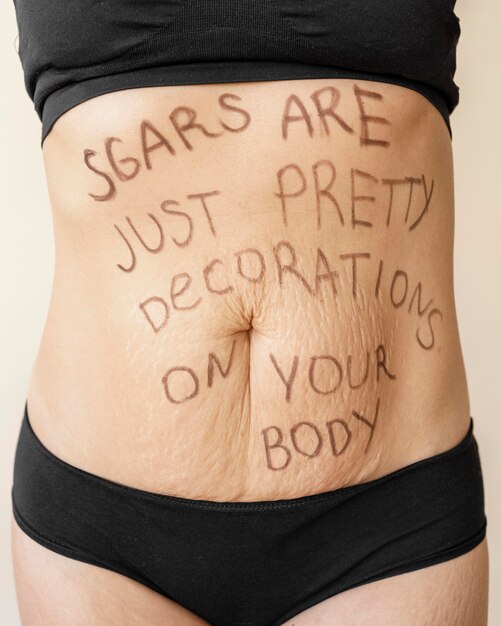
Stretch marks, also known as striae, are thin, indented lines that appear on the skin, often found on the stomach, thighs, upper arms, buttocks, and breasts. These marks usually start off as red and fade to a white or silvery color over time. Common causes of stretch marks include pregnancy, rapid weight changes, and hormonal shifts. While they don’t vanish completely, their appearance can be reduced with treatments or time.
### Why Stretch Marks Happen
Stretch marks typically form when the skin is stretched quickly and beyond its natural limits, causing tears in the dermis. Women are more likely to develop them due to pregnancy, as the body undergoes rapid changes, particularly in the stomach and breast areas. Weight gain or loss, adolescents entering puberty, and certain medical conditions can also lead to stretch marks.
#### Hormonal Changes
Hormonal fluctuations, particularly an increase in cortisone, can weaken the skin’s elasticity. This is common during pregnancy, puberty, or periods of significant weight change. Cortisone, a hormone produced by the adrenal glands, plays a big role in the skin’s ability to stretch. If there’s an overproduction of this hormone, the skin may lose its flexibility, making stretch marks more likely.
#### Pregnancy
More than 60% of women experience stretch marks during or after pregnancy, especially as their stomach and breasts grow in the later months. Using creams designed to prevent stretch marks may help, but they offer no guarantees.
#### Weight Fluctuations
Gaining or losing weight rapidly can cause the skin to stretch or shrink suddenly, resulting in marks—especially on the stomach, thighs, arms, and buttocks. Athletes and bodybuilders who frequently adjust their weight for competitions are particularly prone to stretch marks in areas like the upper arms and thighs.
#### Puberty
Adolescents often experience stretch marks during puberty due to the rapid changes in their developing bodies. Girls may notice marks on their thighs, hips, and breasts, while boys might see them on their shoulders or backs.
#### Medical Conditions
Certain medical conditions like Cushing syndrome, Marfan syndrome, and Ehler-Danlos syndrome can increase the likelihood of stretch marks due to changes in cortisol levels or skin fragility. These conditions often make the skin less elastic, leading to more pronounced stretch marks.
#### Corticosteroid Products
Frequent use of corticosteroid creams, lotions, or pills can thin the skin and reduce its elasticity, contributing to the formation of stretch marks.
### How Stretch Marks Are Diagnosed
Doctors can easily identify stretch marks through a simple physical examination. They may review medical history or current medications to identify potential underlying causes. In rare cases, additional tests like bloodwork or scans may be required if a health condition is suspected.
### Treatments to Reduce Stretch Marks
Although stretch marks don’t disappear completely, their visibility can be significantly reduced through various treatments:
1. **Laser Therapy**:
Laser treatments can target both new and old stretch marks. Pulsed dye lasers are used to treat newer, red-colored marks, while resurfacing lasers smooth out older, white stretch marks.
2. **Microdermabrasion**:
This process exfoliates the outermost layer of the skin using tiny crystals, encouraging collagen production and revealing a newer skin layer underneath.
3. **Tummy Tucks**:
A tummy tuck (abdominoplasty) is a surgical procedure that physically removes the stretch-marked skin on the abdomen. While effective, this method is costly and invasive.
4. **Chemical Peels**:
Chemical peels use alpha-hydroxy acids to damage the top layer of the skin, prompting new skin growth. Over time, this can help reduce the visibility of stretch marks.
5. **Microneedling**:
Microneedling involves inserting fine needles into the skin to promote collagen production, improving skin texture and elasticity without causing significant damage.
6. **Tretinoin Cream**:
Tretinoin is a vitamin A-based cream that helps boost collagen production in the affected areas, improving skin elasticity and the overall appearance of stretch marks.
### Natural Remedies for Stretch Marks
For those who prefer home-based remedies, several natural treatments can help reduce stretch marks over time:
– **Olive Oil**: Massaging olive oil into the skin can improve hydration and elasticity, thanks to its vitamin A, D, and E content.
– **Alfalfa Paste**: Rich in amino acids and vitamins, alfalfa can smooth and repair skin damaged by stretch marks.
– **Potatoes**: Applying potato juice or paste can help rejuvenate skin cells, thanks to its vitamins and minerals.
– **Cocoa Butter**: Lotions with cocoa butter can help moisturize the skin and reduce the appearance of marks.
– **Sugar Scrub**: Mixing sugar with essential oils or honey creates a natural exfoliant that removes dead skin cells, promoting healthier-looking skin.
### Preventing and Managing Stretch Marks
While you can’t always avoid stretch marks, taking good care of your skin can help. Keeping skin well-moisturized, maintaining a healthy weight, and addressing any medical issues early on can make a difference. Remember, stretch marks are a natural part of life for many people, and with the right care or treatment, their appearance can be minimized over time.